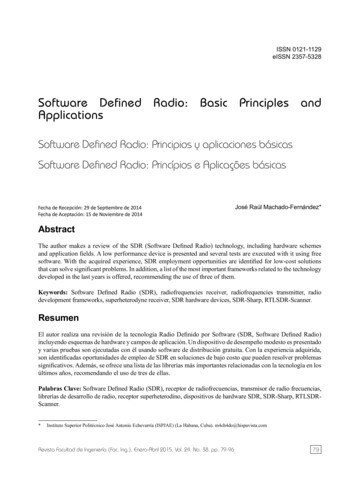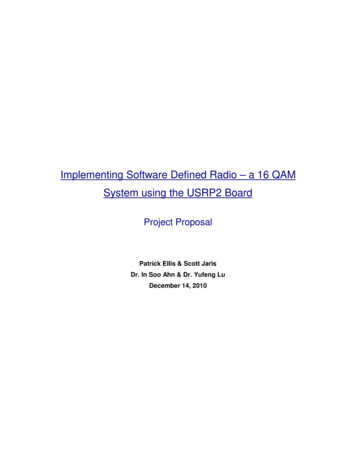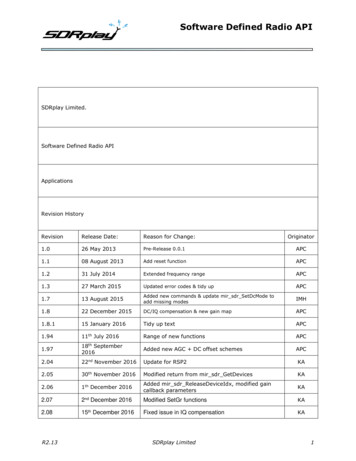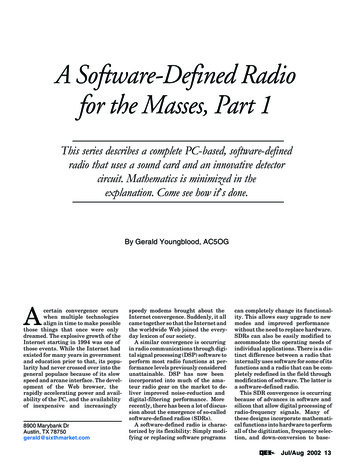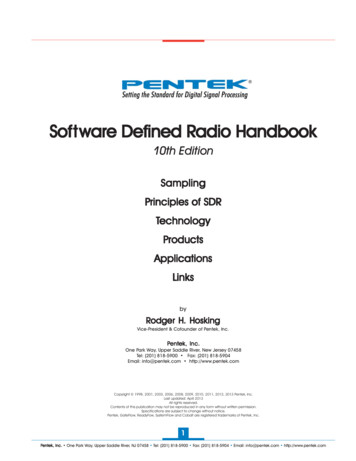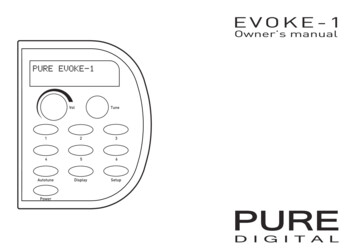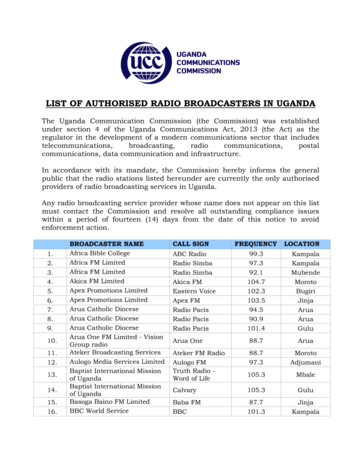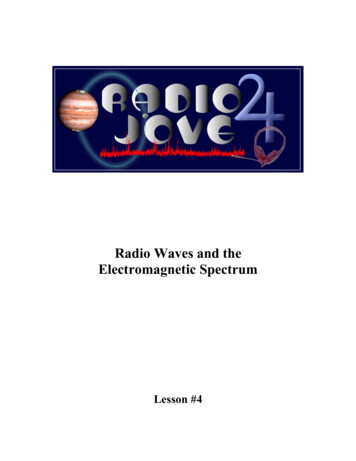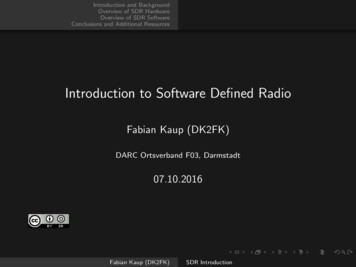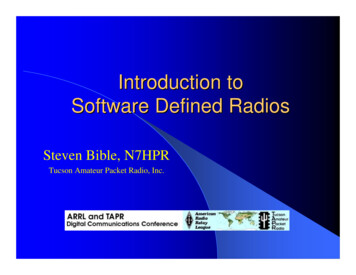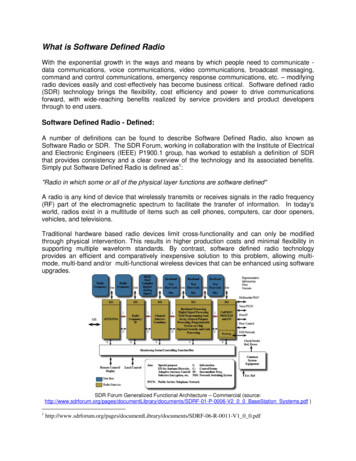
Transcription
What is Software Defined RadioWith the exponential growth in the ways and means by which people need to communicate data communications, voice communications, video communications, broadcast messaging,command and control communications, emergency response communications, etc. – modifyingradio devices easily and cost-effectively has become business critical. Software defined radio(SDR) technology brings the flexibility, cost efficiency and power to drive communicationsforward, with wide-reaching benefits realized by service providers and product developersthrough to end users.Software Defined Radio - Defined:A number of definitions can be found to describe Software Defined Radio, also known asSoftware Radio or SDR. The SDR Forum, working in collaboration with the Institute of Electricaland Electronic Engineers (IEEE) P1900.1 group, has worked to establish a definition of SDRthat provides consistency and a clear overview of the technology and its associated benefits.Simply put Software Defined Radio is defined as1:"Radio in which some or all of the physical layer functions are software defined"A radio is any kind of device that wirelessly transmits or receives signals in the radio frequency(RF) part of the electromagnetic spectrum to facilitate the transfer of information. In today'sworld, radios exist in a multitude of items such as cell phones, computers, car door openers,vehicles, and televisions.Traditional hardware based radio devices limit cross-functionality and can only be modifiedthrough physical intervention. This results in higher production costs and minimal flexibility insupporting multiple waveform standards. By contrast, software defined radio technologyprovides an efficient and comparatively inexpensive solution to this problem, allowing multimode, multi-band and/or multi-functional wireless devices that can be enhanced using softwareupgrades.SDR Forum Generalized Functional Architecture – Commercial ary/documents/SDRF-01-P-0006-V2 0 0 BaseStation Systems.pdf cuments/SDRF-06-R-0011-V1 0 0.pdf
SDR defines a collection of hardware and software technologies where some or all of the radio’soperating functions (also referred to as physical layer processing) are implemented throughmodifiable software or firmware operating on programmable processing technologies. Thesedevices include field programmable gate arrays (FPGA), digital signal processors (DSP),general purpose processors (GPP), programmable System on Chip (SoC) or other applicationspecific programmable processors. The use of these technologies allows new wireless featuresand capabilities to be added to existing radio systems without requiring new hardware.Software Defined Radio - Benefits:The benefits of SDR are compelling.For Radio Equipment Manufacturers and System Integrators, SDREnables: A family of radio “products” to be implemented using a commonplatform architecture, allowing new products to be more quicklyintroduced into the market.Software to be reused across radio "products", reducing developmentcosts dramatically. Over-the-air or other remote reprogramming, allowing"bug fixes" to occur while a radio is in service, thusreducing the time and costs associated with operation andmaintenance.For Radio Service Providers, SDR Enables: New features and capabilities to be added to existing infrastructure without requiringmajor new capital expenditures, allowing service providers to quasi-future proof theirnetworks.The use of a common radio platform for multiple markets, significantly reducing logisticalsupport and operating expenditures.Remote software downloads, through which capacity can be increased, capabilityupgrades can be activated and new revenue generating features can be inserted.For End Users - from business travelers to soldiers on the battlefield, SDRtechnology aims to: Reduce costs in providing end-users with access to ubiquitous wirelesscommunications – enabling them to communicate withwhomever they need, whenever they need to and in whatever manneris appropriate.Software Defined Radio - Rate of Adoption:The SDR Forum commissioned a number of research reports in 2006 to evaluate the adoptionof SDR technologies in various markets. The results of these studies demonstrated that, in
certain markets, SDR is moving beyond the innovators and early adopters as defined byGeoffrey Moore in “Crossing the Chasm” into the early majority phase defining the mainstreammarket2. In this phase, adopters select a technology not because it is innovative or visionary butbecause it has been shown to successfully solve a problem within their specific market.Examples of SDR adoption illustrating the transition to the mainstream are abundant: Thousands of software defined radios have been successfullydeployed in defense applications Cellular infrastructure systems are increasingly using programmableprocessing devices to create “common platform” or “multibandmultiprotocol”base stations supporting multiple cellularinfrastructure standards Cellular handsets are increasingly utilizing System on Chip (SoC)devices that incorporate programmable “DSPCores” to support the baseband signal/modem processing Satellite “modems” in the commercial and defense markets makepervasive use of programmable processing devices for intermediatefrequency and baseband signal processingWhile these types of systems are often not marketed as “SDR’s”, they utilizeand benefit from SDR technologies to solve market specific problems such as;cost of development, cost of production, cost of upgrades and maintenance,time to market in supporting new and evolving air interface standards, orproblems associated with network interoperability.In addition, the SDR Forum’s market and technology studies have shown that costeffective radio frequency technologies supporting the operation of software definedradios over a broad spectral range have begun to mature, allowing for the first timethe use of software defined radio as an enabling technology for dynamic spectrumaccess systems with cognitive or smart radio functionality. This trend is expectedto continue over the next several years, allowing SDR to finally achieve the definedvision of reducing costs in providing end-users with access to ubiquitous wirelesscommunications – enabling them to communicate with whomever they need,whenever they need to and in whatever manner is appropriate2Geoffrey A. Moore, Crossing the Chasm (Revised Addition), Harper Collins Publishers, 2002
Software Defined Radio – Value Chain:The time is now to engage SDR at all levels of the chainThe benefits and anticipated opportunities for SDR technology are having a significant impacton the wireless industry’s value chain. This chain consists of product-based and service-basedproviders, with value added at each stage, ultimately resulting in SDR end products andservices that meet the needs of the end users and subscribers.Throughout the chain, the providers may be supported by external organizations such aseducational institutions, research laboratories, industry standards bodies, investors, tests &verification and government.These supporting organizations provide critical input asdevelopment progresses through the chain, ultimately reaching the end user. The detail of thechain and the relationship within the context of the SDR Forum membership is outlined below.SDR Value Chain: Product and Service Based Providers and Supporting Organizations (Source:SDR Forum 2005 Year Book)Please note: companies may represent more than one category in the value chain. Forinstance, some defense contractors develop their own SDR subsystems and applicationsoftware. Equally most component providers also provide development tools.SDR has far reaching implications within the chain impacting a variety of organizations andindustry sectors through the radio frequency (RF) chain (front end components, softwaredevelopers, chips makers, etc) and throughout business modes (service providers, OEMs, IPholders, etc.). In order to provide viable products and services to meet the future developmentpotential of SDR technology, organizations must look to structure SDR into all levels of thevalue chain. With successful applications seen in a number of markets, the opportunity to fullyengage SDR at all levels of the chain is now.
The SDR Forum engages world class technical, business and government leaders from EMEA,Asia and the Americas, at all levels of the wireless industry's value chain. These members arecommitted to solving their customers' communications problems through families of radiodevices that support a broad range of disparate wireless networks, evolving standards, and theaddition of value added services. The dedication to promoting the success of next generationradio technologies that will inherently support software defined and cognitive radio (CR)capabilities is at the foundation of the Forum. Through its collective industry strength the Forumcan support the adoption of SDR technologies through the value chain through advocacy,opportunity development, commercialization and education.Software Defined Radio - Related TechnologiesSDR can act as a key enabling technology for a variety of other reconfigurable radio equipmentscommonly discussed in the advanced wireless market.3 While SDR is not required to implementany of these radio types, SDR technologies can provide these types of radio with the flexibilitynecessary for them to achieve their full potential, the benefits of which can help to reduce costand increase system efficiencies:Adaptive RadioAdaptive radio is radio in whichcommunications systems have a means ofmonitoring their own performance andmodifying their operating parameters toimprove this performance. The use of SDRtechnologies in an adaptive radio systemenables greater degrees of freedom inadaptation, and thushigher levels of performance and betterquality of service in a communications link.Cognitive RadioCognitive radio is radio in whichcommunication systems are aware of theirinternal state and environment, such aslocation and utilization on RF frequencyspectrum at that location. They can makedecisions about their radio operatingbehaviour by mapping that informationagainst predefined objectives.Venn diagram illustrating relationship betweenassociated advanced wireless technologiesCognitive radio is further defined by many to utilize Software Defined Radio, Adaptive Radio,and other technologies to automatically adjust its behaviour or operations to achieve ary/documents/SDRF-06-R-0011-V1 0 0.pdf
objectives. The utilization of these elements is critical in allowing end-users to make optimal useof available frequency spectrum and wireless networks with a common set of radio hardware.As noted earlier, this will reduce cost to the end-user while allowing him or her to communicatewith whomever they need whenever they need to and in whatever manner is appropriate.Intelligent RadioIntelligent radio is cognitive radio that is capable of machine learning. This allows the cognitiveradio to improve the ways in which it adapts to changes in performance and environment tobetter serve the needs of the end user.These types of radio – adaptive radio, cognitive radio and intelligent radio – do not necessarilydefine a single piece of equipment, but may instead incorporate components that are spreadacross an entire network.
Simply put Software Defined Radio is defined as1: "Radio in which some or all of the physical layer functions are software defined" A radio is any kind of device that wirelessly transmits or receives signals in the radio frequency (RF) part of the electromagnetic spectrum to facilitate the tr
